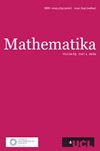Exponentially larger affine and projective caps
IF 0.8
3区 数学
Q2 MATHEMATICS
引用次数: 2
Abstract
In spite of a recent breakthrough on upper bounds of the size of cap sets (by Croot, Lev and Pach and by Ellenberg and Gijswijt), the classical cap set constructions had not been affected. In this work, we introduce a very different method of construction for caps in all affine spaces with odd prime modulus p. Moreover, we show that for all primes with , the new construction leads to an exponentially larger growth of the affine and projective caps in and . For example, when , the existence of caps with growth follows from a three-dimensional example of Bose, and the only improvement had been to by Edel, based on a six-dimensional example. We improve this lower bound to .

指数更大的仿射帽和射影帽
尽管最近在帽集大小的上限上取得了突破(由Croot, Lev和Pach以及Ellenberg和Gijswijt),但经典帽集结构并未受到影响。在这项工作中,我们引入了一种非常不同的构造方法,用于所有具有奇素模量p的仿射空间中的帽。我们证明了对于所有素数p≡5 mod 6 $p \equiv 5 \bmod 6$ p≤41 $p \leqslant 41$,新结构导致AG (n, p) ${\rm AG}(n,p)$和PG (n)中的仿射帽和射影帽呈指数级增长;P) ${\rm PG}(n,p)$。例如,当p = 23 $p=23$,生长(8.0875…)n $(8.0875\ldots )^n$的帽状物的存在源自玻色的三维例子,唯一的改进是Edel基于一个六维的例子得出(8.0901…)n $(8.0901\ldots )^n$。我们把这个下界改进为(9−0 (1))n $(9-o(1))^n$。
本文章由计算机程序翻译,如有差异,请以英文原文为准。
求助全文
约1分钟内获得全文
求助全文
来源期刊

Mathematika
MATHEMATICS, APPLIED-MATHEMATICS
CiteScore
1.40
自引率
0.00%
发文量
60
审稿时长
>12 weeks
期刊介绍:
Mathematika publishes both pure and applied mathematical articles and has done so continuously since its founding by Harold Davenport in the 1950s. The traditional emphasis has been towards the purer side of mathematics but applied mathematics and articles addressing both aspects are equally welcome. The journal is published by the London Mathematical Society, on behalf of its owner University College London, and will continue to publish research papers of the highest mathematical quality.
 求助内容:
求助内容: 应助结果提醒方式:
应助结果提醒方式:


